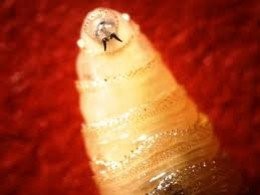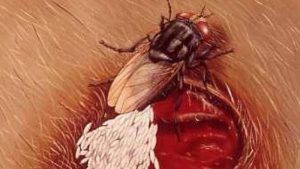Paws-itive Press
SCREWWORM
By Christina Anzures

Screwworms are fly larvae (maggots) that feed on living flesh. These parasites can infect any warm-blooded animal, including humans. Screwworms can enter wounds as well as body orifices, and feed on living tissue in that area. If untreated, screwworm infestations can be fatal. Screwworm has been eradicated in the United States (U.S.), but reintroductions do occur, most commonly in imported dogs and horses. Screwworm is a foreign animal disease and must be reported to the Florida Department of Agriculture or USDA animal health officials within 24 hours of diagnosis.
 New World screwworm, Cochliomyia hominivorax, is found primarily in tropical areas of South America and some Caribbean Islands. USDA, National Veterinary Services Laboratories, has confirmed 17 cases of screwworm in the Keys and Homestead Florida since September 2016 affecting Key deers, dogs, cats, a pig and a racoon.
New World screwworm, Cochliomyia hominivorax, is found primarily in tropical areas of South America and some Caribbean Islands. USDA, National Veterinary Services Laboratories, has confirmed 17 cases of screwworm in the Keys and Homestead Florida since September 2016 affecting Key deers, dogs, cats, a pig and a racoon.
An adult screwworm fly can travel up to 125 miles before laying eggs in a wound. Screwworms can also be transported by animals and people travelling from infested areas. FDACS established an animal health check point for travelers moving north with pets and livestock.
 Female screwworm flies are attracted to all warm-blooded animals. Wounds that might become infested include those caused by: Tick bites, Castration, Dehorning, Branding, Shearing, and Sore mouth in sheep. In addition, screwworms can infest the navels of newborn mammals, and mucous membranes of bodily orifices, including: nostrils and sinuses, eyes, mouth, ears, vulva, anus, prepuce, and urethral fossa.
Female screwworm flies are attracted to all warm-blooded animals. Wounds that might become infested include those caused by: Tick bites, Castration, Dehorning, Branding, Shearing, and Sore mouth in sheep. In addition, screwworms can infest the navels of newborn mammals, and mucous membranes of bodily orifices, including: nostrils and sinuses, eyes, mouth, ears, vulva, anus, prepuce, and urethral fossa.
It may be difficult to visualize the screwworm maggots at the wound surface, since only the breathing tubes of the maggot are exposed. As the larvae feed on live tissue, they burrow into the tissue creating a deeper and wider wound. This deep burrowing is a distinctive feature of screwworms; other maggots are surface feeders on dead tissue.
Infested animals may present with enlarging, draining, foulsmelling wounds and weight loss; they may isolate themselves and show signs of discomfort. Animals may die from secondary infection or toxicity in 7-14 days if not treated.
Animal owners should report any unusual looking wounds or maggots on livestock or pets, particularly those imported from countries where screwworm flies are found or with recent history of international travel, to their veterinarian. The veterinarian will examine, collect, and send samples of suspicious larvae preserved in alcohol to the laboratory for identification. If screwworm is suspected in a person, they should contact their physician immediately.
The U.S. Fish and Wildlife Services has been working with wildlife veterinarians to evaluate and select treatments to prevent healthy Key deer from becoming infested by screwworm, and to treat deer in the early stages of infestation.
Deer are being marked with non-toxic paint to identify those who have been treated.
USDA has released 104 million sterile flies in the Keys and Homestead as part of the eradication program.
Please visit FreshFromFlorida.com to find out more information about screwworm and report it by calling 1-800-HELP-FLA.
As with every disease, early detection is key, and this disease can be treated.

Cristina Anzures
Anzer Animal Hospital co -owner.
Lives in Wellington with her husband and 2 kids.
Passionate about regulatory medicine and well being of all animals.
Works for the Florida Dept. of Agriculture.

